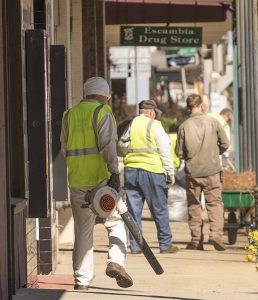
By DON FLETCHER
News Staff Writer
Back in the days of prison “chain gangs,” inmates who swung sling blades or axes along county and municipal roadsides were said to be paying their debt to society. The days of shackled-together inmate work crews have gone, but many inmates are still paying their societal debt by working outside the razor wire of a state prison compound.
Atmore, with a three-facility state prison compound just outside its city limits, has been one of the biggest beneficiaries of the Alabama Department of Corrections’ Community Work Program.
Under the program, state inmates assigned to minimum-custody correctional facilities — such as the Fountain Correctional Annex, where local work-release inmates are housed now that the DOC’s J.O. Davis facility is closed — are considered for work details with city, county and state government agencies.
Inmates from the Fountain Annex perform various labor duties for the cities of Atmore, Brewton and Flomaton, as well as for Escambia County.
Atmore Mayor Jim Staff said the program has been a blessing for the city over the past several years, providing much of the manpower needed to operate the city’s Sanitation and Streets, Cemetery and Beautification departments.
“It sure is good for us,” Staff said. “Take our Street and Sanitation Department — I forget how many employees used to be there, but prisoners are doing that work now. They save the city a bunch of money, they do a fantastic job and they don’t fuss. There’s been one or two of them I wanted to hire. Some of them are sure enough good folks who just got caught in the wrong place at the wrong time.”
Work-release inmates also receive a boxed lunch each Friday, and occasionally they get a taste of home cooking that they can’t get inside a prison.
“We have some individuals and organizations that occasionally feed them lunch,” the mayor said. “And we throw a little fish fry for them every now and then, too, just to show them that we appreciate all they do.”
ALDOC spokesman Bob Horton said cities, towns and other government agencies that use CWP resources pay a daily fee of $15 per inmate. That fee is used to cover the costs of transporting the inmates to and from their work assignments, as well as other program operating expenses, and each work-release inmate receives $2 per day.
Horton said prisoners may be considered for the program when they meet minimum criteria for placements at a work release and community work center.
ALDOC makes a final determination based on “the totality of the inmate’s record.” Inmates who are nearing the end of their sentence, or close to a possible parole date, may be assigned to a minimum custody level correctional facility, if they meet all the criteria. Inmates who have been sentenced to life without parole or consecutive life sentences are not eligible for work release.
Currently, nearly 1,700 Alabama inmates are serving time in Community Work Centers, Horton said. The state prison system currently includes 11 Work Release or Community Work Centers in addition to the Fountain Annex, one each in Alexander City, Birmingham, Camden, Childersburg, Decatur, Elba, Deatsville, Hamilton, Loxley, Mobile and Montgomery.
Corrections officials feel that the prison-free world partnership is of significant benefit.
“Realization that the community has become a partner in the rehabilitation process aids in restoring the inmate’s confidence and self-assurance of success when released,” Horton explained. “In addition, the program gives the Board of Pardons and Paroles a means of evaluating the inmate’s suitability for parole by using the inmate’s community work experience as a measure to determine the inmate’s success when paroled.”
Atmore City Clerk Becca Smith said the city uses an average of “around 19” inmates each weekday and pays “about $92,000 per year” for the inmate labor. She compared that to the estimated cost of hiring 19 employees, even at near-minimum wage rates.
“They would probably be paid way more than that, but just say they made $7.50 per hour, for 40 hours a week,” Smith said. “That’s $15,600 a year in wages. Plus, the city pays $24,000 for family insurance coverage and doesn’t charge the employee but $200.
“So, if 19 people made $15,600 a year and we paid their insurance, it would cost about $615,000 a year. And that doesn’t include social security, unemployment or any of that.”
Staff agreed that the program is beneficial for all parties, not just corrections officials.
“It’s a deal, any way you look at it; it’s beneficial to both of us, the city and the inmate,” he said. “This is a way for them to actually pay their debt to society, and I really don’t know how we would operate without them.”
